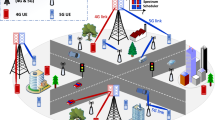Abstract
Under the conventional approach of spectrum sensing in a cognitive radio (CR) system, in the start of each frame of duration \(T\) a time slot \(\tau\) is allocated for the spectrum sensing and \(T - \tau\) for the data transmission. During the sensing duration \(\tau\), no data transmission is allowed, this invites a serious problem of sensing-throughput tradeoff. To overcome the problem of sensing-throughput tradeoff, this paper presents a new approach which with the help of the proposed decoder structure enables the CR system to execute the tasks of spectrum sensing and data transmission simultaneously. Under the proposed approach, the CR does not only ensure a sufficient level of protection required by the licensed users, but also improves utilization of underutilized portion of the licensed spectrum which is reflected in terms of its improved achievable throughput. The proposed approach is also implemented under the m-out-of-k rule of cooperation to overcome the effects of channel uncertainties such as the shadowing, multipath fading and the hidden terminal problems, resulting in a significant increase in its throughput compared to that under the non-cooperation.








Similar content being viewed by others
Notes
Since, the transmitting and scanning antennas exist within the same section, the distance between them can be neglected. So, the total loss from the transmitting antenna to the scanning antenna generally includes the system loss and the loss incurred due to orientation of the scanning antenna with respect to the transmitting antenna.
References
Federal Communications Commission (2002). Spectrum policy task force report. FCC 02–155.
Mitola, J., & Maguire, G. Q. (1999). Cognitive radio: Making software radios more personal. IEEE Communications, 6(4), 13–18.
Akyildiz, I. F., Lee, W.-Y., Vuran, M. C., & Mohanty, S. (2006). Next generation/dynamic spectrum access/cognitive radio wireless networks: a survey. Computer Networks, 50(13), 2127–2159.
Ghasemi, A., & Sousa, E. S. (2007). Fundamental limits of spectrum-sharing in fading environments. IEEE Transactions on Wireless Communications, 6(2), 649–658.
Tandra, R., Mishra, S. M., & Sahai, A. (2009). What is a spectrum hole and what does it take to recognize one? Proceedings of the IEEE, 97(5), 824–848.
Liang, Y.-C., et al. (2008). Sensing-throughput tradeoff for cognitive radio networks. IEEE Transactions on Wireless Communications, 7(4), 1326–1337.
Peh, E. C. Y., & et al. (2009). Optimization of Cooperative sensing in cognitive radio networks: A sensing-throughput tradeoff view. IEEE Transactions on Vehicular Technology, 58(9), 5294–5299.
Verma, G., & Sahu, O. P. (2016). Intelligent selection of threshold in cognitive radio system. Telecommunication Systems. doi:10.1007/s11235-016-0141-y.
Zou, Y., & et al. (2010). Spectrum sensing and data transmission tradeoff in cognitive radio networks. In Wireless and optical communications conference (WOCC), pp. 1–5. doi:10.1109/WOCC.2010.5510601,
Tang, L., et al. (2011). Effect of primary user traffic on sensing-throughput tradeoff for cognitive radios. IEEE Transactions on Wireless Communications, 10(4), 1063–1068.
Pradhan, H., et al. (2015). Sensing-throughput tradeoff in cognitive radio with random arrivals and departures of multiple primary users. IEEE Communication Letters, 19(3), 415–418.
Nie. G., & et al. (2012). Sensing-throughput tradeoff in cluster based cooperative cognitive radios: A novel frame structure. In Vehicular technology conference, an IEEE conference, pp. 1–5. doi:10.1109/VETECS.2012.6240200.
Guerrine, M. (2013). Sensing-throughput tradeoff for cognitive radios. In IEEE workshop on signal processing advances in wireless communications (SPAWC), pp. 115–119. doi:10.1109/SPAWC.2013.6612023.
Kan, C., & et al. (2012). Sensing-throughput tradeoff for interference-aware cognitive radio networks. In IEEE international conference on computer science and network technology (ICCSNT), pp. 660–665. doi:10.1109/ICCSNT.2012.6526022.
Bogale, T. E., & et al. (2014). Sensing throughput tradeoff for cognitive radio networks with noise variance uncertainty. In IEEE international conference on cognitive radio oriented wireless networks and communications (CROWNCOM), pp. 435–441. doi:10.4108/icst.crowncom.2014.255811.
Zhang, S., & et al. (2015). A cross-layer aware sensing-throughput tradeoff for multi-channel cognitive radio networks. In IEEE vehicular technology conference (VTC), pp. 1–5. doi:10.1109/VTCSpring.2015.7145595.
Verma, G., & Sahu, O. P. (2016). Interference aware sensing scheme in cognitive radio system. Wireless Personal Communications. doi:10.1007/s11277-016-3688-8.
Wang, Y., et al. (2014). Optimization of cluster-based cooperative spectrum sensing scheme in cognitive radio networks with soft data fusion. Wireless Personal Communications,. doi:10.1007/s11277-014-1673-7.
Verma, G., & Sahu, O. P. (2016). Opportunistic selection of threshold in cognitive radio networks. Wireless Personal Communications. doi:10.1007/s11277-016-3573-5.
Zhang, W., et al. (2009). Optimization of cooperative spectrum sensing with energy detection in cognitive radio networks. IEEE Transactions on Wireless Communications, 8(12), 5761–5766.
Author information
Authors and Affiliations
Corresponding author
Rights and permissions
About this article
Cite this article
Verma, G., Sahu, O.P. Removal of Sensing-Throughput Tradeoff Barrier in Cognitive Radio Networks. Wireless Pers Commun 94, 1477–1490 (2017). https://doi.org/10.1007/s11277-016-3693-y
Published:
Issue Date:
DOI: https://doi.org/10.1007/s11277-016-3693-y




